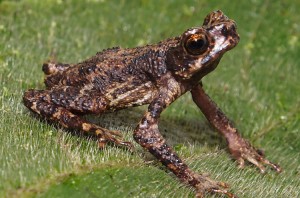Sumatra’s New Orangutans
Friday, December 15th, 2017December 15, 2017
On the Indonesian island of Sumatra, already home to the Sumatran orangutan, a new species of the great orange ape has recently been named: the Tapanuli orangutan (Pongo tapanuliensis). Orangutans are shy and reclusive, and they live in remote jungle areas. This, combined with their small numbers, can make the animals extremely hard to find. It is little wonder, then, that every once in a while people should learn of a new species. Since 2001, the Tapanuli is the third newly recognized species of orangutan, following its recently named Sumatran cousins (Pongo abelii) and the Bornean orangutan (Pongo pygmaeus). An international team of anthropologists and evolutionary biologists recently described the Tapanuli species in the journal Current Biology. Among all the great apes, the Tapanuli orangutan’s population is the smallest. The team estimated Tapanuli numbers at just 800.

A Tapanuli orangutan relaxes in the comfort of a tree on the island of Sumatra. Credit: Tim Laman (licensed under CC BY 4.0)
In the 1930’s, scientists reported an orangutan population in the rain forest of Batang Toru on Sumatra. However, it was not until 1997 that scientists rediscovered the population and later began studying the animals. Michael Krützen, a Swiss evolutionary geneticist from the University of Zurich, is one of the authors of the Current Biology report. Krützen believes the new orangutan species differs genetically, physically, and behaviorally from both the Sumatran and Bornean species. The three species also seem to have distinct evolutionary lineages. Tapanuli orangutans are believed to be direct descendants of the first orangutans that arrived in Sumatra from mainland Asia long ago.
Tapanuli orangutans are found only in the isolated high-elevation rain forest of Batang Toru. Their small population is distributed over about 386 square miles (1,000 square kilometers), an area roughly the size of Dallas, Texas. Calls made by Tapanuli males vary from calls made by Sumatran and Bornean males. Sumatran males produce calls that are long and low-pitched, while those on Borneo belt out shorter and higher-pitched calls. The calls of Tapanuli males fall somewhere in between.
Tapanuli orangutans have slightly different facial features (including a noticeable mustache) from other orangutans, as well as smaller skulls. Female Tapanuli orangutans have beards, unlike Bornean orangutans. Tapanuli fur is slightly different, too: frizzier and more cinnamon-colored. The analysis of Tapanuli bones, plus a genetic review of blood samples, convinced the anthropologists and biologists that they had found a unique orangutan species.
Jungle cats hunt Tapanuli orangutans, but otherwise the apes have few natural predators. Human activity poses the biggest threat. The spread of agriculture, particularly palm oil plantations, has greatly reduced the orangutan’s habitat. Plans for a gold mine and a hydroelectric plant in the area also pose threats to the animal’s Batang Toru forest. With only about 800 Tapanuli orangutans living in the wild, urgent study and conservation is needed to help protect the endangered orange apes from extinction.




